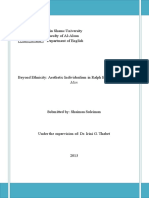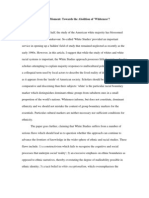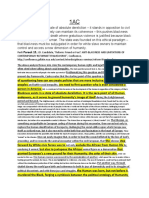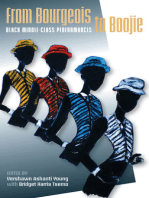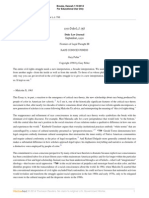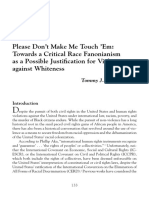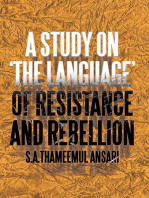From Invisibility To Unmarking: Reflections On African-American Literature
From Invisibility To Unmarking: Reflections On African-American Literature
Uploaded by
aanndmaiaCopyright:
Available Formats
From Invisibility To Unmarking: Reflections On African-American Literature
From Invisibility To Unmarking: Reflections On African-American Literature
Uploaded by
aanndmaiaOriginal Title
Copyright
Available Formats
Share this document
Did you find this document useful?
Is this content inappropriate?
Copyright:
Available Formats
From Invisibility To Unmarking: Reflections On African-American Literature
From Invisibility To Unmarking: Reflections On African-American Literature
Uploaded by
aanndmaiaCopyright:
Available Formats
HANS LÖFGREN
From Invisibility to Unmarking:
Reflections on African-American Literature
Discussions of literature in terms of ideological content or political implications
typically focus on one or more of three major categories—race, sex and class—often
adding ethnicity as an alternative or complement to race. The ambiguity of whether
race and ethnicity are the same or different, even though the first has certain
biological connotations by contrast with the stronger cultural connotations of the
second, suggests that these terms are unstable, lacking inner coherence. While race,
sex, and class are all culturally constructed, the latter two have a material basis which
race lacks. Even if gender characteristics in any concrete social instance always have
a cultural character, it would be difficult to maintain the argument that there are no
biological differences between males and females. And even if class requires the
conscious differentiation of us and them, economic differences are still the condition
for this consciousness to arise. With race however, things are different.
It might appear that race is a biological category, having to do with the physical
characteristics shared by those belonging to the same gene pool, and expressing itself
in terms of skin color, body proportions, special facial features and so on. But this
superficial notion of race not only leaves unanswered the question of what possible
implications such differences could have for social relations; even a simple criterion
such as skin color proves inadequate for determining race. Let us perform a simple
thought experiment to test this criterion. It is commonly said that the current president
of the United States is black, or African American. Why? Because his partly African
parentage is expressed in physical features such as skin color. Imagine, however, that
the majority of Americans were black. It would then logically follow that anyone
showing traits of whiteness would belong to the minority group, just as anyone
recognized as being partly of African descent in the United States today is considered
to be black, and usually self-identified as black. In that hypothetical United States
with a black majority the current president of the United States would be—using the
same logic as we use today—white. What is the race of a particular person? Logically
speaking, it depends, and if we add that racial classification is not complete without
reference to shared cultural traits and traditions, things get even more complicated. In
fact, President Obama’s racial identity has been problematized in the American press
with regard to his unique cultural background.
© Moderna språk 2010:1 15
This thought experiment supports the notion that race is metaphysical, a mental
construct mystically appearing in the form of a timeless, unchangeable reality. But
does it then follow that all problems having to do with racial difference can be
eliminated by an act of demystification? Unfortunately not. As one prominent
African-American literary critic complained, the notion that race is a metaphysical
illusion was for him easily refuted by his repeated failures to hail a taxi in mid-town
Manhattan. Even though the term race as commonly applied has no clear material
basis, it acquires material characteristics as a consequence of social actions.
One might wonder, however, whether racial issues would disappear if we could
promote a colorblind society. For example, if race was not a category in government
census-taking or in any other institutional procedure, wouldn’t it ultimately wither
away? Again, unfortunately, things are not that simple. For one thing, colorblindness
would be inconsistent with affirmative action policies having the goal of
compensating the historical legacy of oppression that has produced the current state
of unequal opportunity. For another, resistance to racism demands group solidarity.
More importantly, African Americans as a self-defined group have an interest in
identifying themselves as both same and different—in terms of a common humanity
and in terms of a separate community that preserves its own integrity and values, its
own culture and politics. As long as whiteness is the primary and privileged term,
with blackness as the derivative, race distinctions constitute a dilemma. As long as
white is the unmarked and black is the marked race, black people will be caught in a
double bind. If a literary character is not assigned a race in an American context or
even within Western culture in general, he or she is assumed to be white. The
dominant culture requires that departures from the white norm have to be explicitly
named. But if race is not marked in some way, that is also an expression of white
hegemony. Same or different? An impossible choice from a subordinate standpoint.
The assertion of the identity of all human beings can be liberating, a blow against
racism; but it can just as well mask racism and cover up the inequality actual
opportunity. The assertion of difference can be a means of cultural resistance and
self-respect, but it can also be self-defeating if it is derivative, a reaction to a
prevailing cultural hegemony that is tacitly taken for granted. Since blackness and
whiteness are not essences, that is to say not realities in themselves but defined in
opposition to each other, neither the assertion of identity nor the assertion of
difference can serve as a permanent strategy or attitude. The effect of such assertions
always has to be gauged in terms of specific situations, and this goes for all political
categories and strategies concerning race. Let us assume, for example, that there is
among the reading public or in the academy a prevailing notion that all African-
American literature should properly address the politics of race, that there is no place
© Moderna språk 2010:1 16
in it for the aestheticism of the dominant culture. In this situation, I would argue, the
assertion that one is primarily a writer, and without a political agenda, may
paradoxically come to be loaded with great political significance.
In what follows, I will discuss African-American texts from the late 50s up to our
time, in terms of three strategies to resolve the dilemma of racialized identity I have
just described:
• a double attitude, involving a subversive or covert opposition, or irony, some-
times using a reversal, turning the dilemma around as belonging to white people;
• self-criticism, relocating or redefining the problem in terms of black people’s
inadequate or excessive valorization of race, as internalized racism or its denial;
• the relativizing or un-marking of race, not identifying characters in terms of race,
or only doing so indirectly when the plot requires it.
These three strategies follow each other in roughly chronological sequence. Since
World War II, African-American literature has undergone a development with respect
to racial themes that can be divided into three moments: the Civil Rights and
integration movements of the 50’s and 60s: the twin claims of Black Aesthetics and
Black Power of the 60s and 70s, now bringing the intersection of race and gender
categories into focus; and the multiculturalism from the 80s up until the present time.
My purpose in this selective survey will be to present some texts, mainly short
stories, in terms of their educational value in teaching about race at the upper
secondary or beginning university level. Naturally, these texts would not lend
themselves so well to this purpose if they were not also excellent choices for teaching
English and literature as such. I begin with Ralph Ellison’s novel Invisible Man,
published in 1952, from which I select the stand-alone first chapter “The Battle
Royal”, then take up an essay from the same period by James Baldwin entitled “My
Dungeon Shook”. In this group I also consider an illustration of how history is not a
perfect linear pattern, the 1993 novel A Lesson before Dying by Ernest J. Gaines,
which returns to a civil rights theme. The next group consists of two stories, “The
Lesson” by Toni Cade Bambara and “Everyday Use” by Alice Walker. In the final
group, I take up two texts that in different ways express a multi-cultural orientation,
Charles Johnson’s novel The Middle Passage and Toni Morrison’s single short story,
“Recitatif”.
Published in the period of global decolonization and just before the demand for civil
rights became a dramatic national issue in the United States, Ralph Ellison’s Invisible
Man was a sensational publishing event. Twelve years later, it was to be judged the
best novel since World War II by two hundred prominent literary critics. Closely
© Moderna språk 2010:1 17
modeled on the life of the author, who rose from working-class beginnings in the
South to an academic career in northeastern United States, the novel portrays the
identity crisis of a man who leaves his southern college for New York City to fulfill
his promise of personal success. He discovers, however, that all his associations in
the North are subtly yet profoundly characterized by racial politics, among blacks as
well as whites. Unable to find personal recognition or an authentic existence among
others, he retreats underground, literally and symbolically. The unnamed protagonist
hibernates, as he says, in a closed-off basement where he awaits a time for returning
to a world where he can genuinely be seen. The invisibility of the differently colored
man is the great theme of the novel, signifying lack of personal recognition and the
relegation to a state of symbolic nonexistence.
The prologue of the novel and its first chapter can be read as independent texts, and
they are often anthologized. This is especially true for the first chapter entitled “Battle
Royal”, which was first published as a short story. It is about a young man who is to
receive an award for his excellent academic record but who is instead mocked by
those who would keep him in his place. A group of white men subject the protagonist
and his fellow distinguished students to a humiliating collective and blindfolded
boxing match. When they are invited to claim their reward in the form of money
thrown across the floor, the young men receive electric shocks. The story reads like
an allegory of the lives of black Americans, falsely offered rewards for their
achievements and their aspirations to equality, tricked into competition with each
other and lured by the false promise of financial success. As the first chapter of
Invisible Man, it is a prophecy of the protagonist’s betrayal and disillusionment, the
failed project of self-actualization that eventually leads him to his underground
existence.
As might be seen in this very brief summary, Ellison draws the conclusion that, for
the time being, no significant social action can be taken—or at least openly
advocated—to address problems of racism. Black people remain caught within the
split identity that DuBois had earlier described as “double consciousness”. The only
action available to the protagonist is symbolically represented by his theft of
electricity from the aptly named “Monopolated Light & Power“, something which
allows him to bask in the light of hundreds of light bulbs that make him eminently
visible. The novel is a forceful confrontation with a white reader, at the same time
openly expressing despair over the racial double bind. As such, Invisible Man
succeeds in asserting the ambivalence and ambiguity of black identity, finding in the
form of literature an alternative which is not present in the world. Yet the message is
also that subversion and an ironic attitude is the only possible form of social
© Moderna språk 2010:1 18
existence. Figuratively, the protagonist reproduces his grandfather’s strategy of social
survival.
On his death-bed he called my father to him and said, “Son, after I’m gone I
want you to keep up the good fight [. . .]. I want you to overcome ‘em with
yeses, undermine ‘em with grins, agree ‘em to death and destruction [. . .] I
was warned emphatically to forget what he said [. . .] It had a tremendous
effect upon me, however, I could never be sure what he meant [. . .]
Whenever things went well for me I remembered my grandfather and felt
guilty and uncomfortable. It was as though I was carrying out his advice in
spite of myself. (17-18)
The narrator/protagonist is ambivalent about this advice, evidently because it is a
legacy from the post-Civil War era of “Reconstruction” that represents white reaction
against the Emancipation of slaves. On the one hand, the grandfather’s advice implies
the necessity of subjection; on the other, it involves an effective form of covert
resistance, a form of passive aggression. Adding to the ambivalence is also the fact
that the strategy which appears to have been a necessity for the grandfather runs the
risk of becoming a factor in the perpetuation of racial subjection for later generations.
A similar emphasis on a double if not duplicitous form of behavior characterizes
some of James Baldwin’s early works. A contemporary of Ellison’s, Baldwin was the
more prominent public figure, a spokesman for African-American civil rights.
Though exposing Christianity as a sham in his autobiographical Go Tell It on the
Mountain, Baldwin’s ethics remain Christian, as is evident in his well-known essay
book, The Fire Next Time. The most important part of Baldwin’s message reverses
the received form of the racial dilemma. It is not black people who have a problem
and who need to be recognized by whites as equal; it is rather white people who are
compromised as oppressors. Black people are by virtue of their politically
subordinate position in a superior position of understanding the other, and it is
therefore, Baldwin counsels, that they must love white people.
On the face of it, this is simply a matter of Christian ethics—love your enemy. But
one might sense in the outraged tone of the book another transformation of the
grandfather’s advice in Invisible Man to “undermine ‘em with yeses”. After all,
Baldwin’s title, The Fire Next Time, is an Old Testament allusion signifying the
wrath of God as the future consequence of continued sinfulness. It is a militant love
that Baldwin advocates, much like the non-violent resistance of Martin Luther King,
Jr and approaching his disciplined control of anger in speeches and actions for
peaceful change. This message is clear in the first, shorter essay in the book entitled
“My Dungeon Shook: Letter to My Nephew on the One Hundredth Anniversary of
© Moderna språk 2010:1 19
the Emancipation”. As if updating and upgrading the grandfather’s advice in Invisible
Man, while echoing Ellison’s key metaphor of invisibility, Baldwin seeks to prepare
his nephew for a rough world:
most of them do not yet really know that you exist [. . .] There is no reason
for you to try to become like white people and there is no basis whatever for
their impertinent assumption that they must accept you. The really terrible
thing, old buddy, is that you must accept them [. . .]. And if the word
integration meetings anything, this is what it means: that we, with love, shall
force our brothers to see themselves as they are.” (16-21)
This forceful love aims to confront white people with the guilt and the alienation
from humanity that results from racist domination. The propitious historical moment
for such a strategy, however, seems to have passed, not only with the end of Civil
Rights demonstrations and the assassination of King, but also with the transformation
of political conditions. When institutionalized racism begins to disappear, at least in
its most obvious forms such as segregationist legislation, opposition to racism
increasingly has to be directed against an internal as well as external agent.
It would be wrong to claim that all works of literature are arranged in some linear
progression, however. There are works close to our time that still adhere to civil
rights ideology and method, for example, Ernest J. Gaines’ A Lesson before Dying,
which portrays a transcendence of racial division by couching resistance to white
racism not as opposition or rebellion, but in terms of a universal level—existential
courage in the face of death. The author was born on a plantation in Louisiana, a
member of the fifth generation to live in that same place. He spent most of his
childhood picking cotton, going to school only five to six months of the year. This is
the sort of world that is reflected in A Lesson before Dying, which returns not only in
its setting to the segregated South of the 1940s, but also in its ideology to the Civil
Rights movement that was soon to follow. The emphasis in this instance is on the
transformation of consciousness, not the eradication of institutionalized segre-
gation. In its sharp differentiation of black and white experience, the novel might
seem to take the sort of identity politics position that is common within the
multicultural approach, but the assertion of a universal value is its major theme.
A Lesson before Dying is a moral tale. It is the story of a young black man who
learns to face his moment of execution with dignity, though his conviction for murder
is wrongful—the racist verdict of the jury of twelve white men. The main issue in the
novel is not proving the innocence of Jefferson, the wrongly convicted man, but in
challenging the inhumanity of his defense by the white, court-appointed lawyer. In
order to convince the jury that the accused could not possibly have committed
© Moderna språk 2010:1 20
premeditated murder, the defense attorney refers to Jefferson not as a man, but as
“anything that acts on command,” and unintelligent animal—“a hog.” This assertion
is something the young man’s godmother cannot accept. She convinces the most
educated black man in town, a schoolteacher, to visit Jefferson in his jail cell in order
to rescue his humanity. She wants her godson to face death with courage and
dignity—not as a “hog” but as a man. After a series of reluctant visits, the school-
teacher is ultimately successful, and in his success—or rather through the courage of
the condemned man—the schoolteacher finds a new meaning in his life. The
condemned man has redeemed the community in breaking the cycle of escapism, the
flight from responsible manhood that is all too familiar in reports about African-
American families.
The next two texts in my selective survey belong to the new historical moment that
follows what we might call the cultural revolution of the 60s. It now becomes
important to locate an internal oppressor and to realize that also the personal is the
political, to use the slogan of the new women’s movement. In Toni Bambara’s short
story collection Gorilla, My Love the story entitled “The Lesson” portrays the
experience of a Harlem school class that encounters for the first time the affluent and
predominantly white culture of downtown Manhattan, as exemplified by an exclusive
shopping district. By contrast, Alice Walker’s short story “Everyday Use” from In
Love and Trouble portrays the idealization of the poor black background from the
perspective of someone who has begun to assert her black identity in a middle class
context. The first story contains a critique of that relatively straightforward distinction
between racially defined “us and them” whose moment of primary importance has
passed. The second contains a critique of the excessive valorization of race in black
nationalism, which is shown to ignore the rights of women as well as idealizing
African-American culture.
Toni Bambara’s experience as a New Yorker deeply committed to social work and
welfare programs is evident in the focus of her fiction on marginal characters,
poverty, children and youth. “The Lesson” is representative in this regard and in its
use of the African-American vernacular. It is a story of mixed success with an
experiment in practical education. A well-meaning woman attempts to teach a group
of children in the Harlem district of New York City about social and economic
inequality—the vast disparities in wealth which become readily apparent as one
travels from uptown Harlem to downtown Manhattan with its fancy Fifth Avenue
shops. As they visit a famous toy store called F. A. O. Schwarz, the teacher aims to
teach the children a lesson by confronting them with their ignorance of social
inequality, shocking them into awareness. In particular, she uses the example of a toy
boat that only extravagantly wealthy people could afford, its price striking the
© Moderna språk 2010:1 21
children as what an actual boat might cost. The narrator of the story, a tough, semi-
delinquent young girl, rejects the moral of the lesson at some expense to herself,
though she elicits the reader’s sympathy. She will not be a good girl and accept Miss
Moore’s self-righteous and dogmatic lesson, which disregards how the children’s
fantasies are caught up in this luxurious world, and how ashamed they consequently
are of their own poverty and ignorance:
Who are these people that spend that much for performing clowns and $1000
for toy sailboats? What kinda work they do and how they live and how come
we ain't in on it? Where we are is who we are, Miss Moore always pointin
out. But it don't necessarily have to be that way, she always adds then waits
for somebody to say that poor people have to wake up and demand their
share of the pie and don't none of us know what kind of pie she talking about
in the first damn place. But she ain't so smart cause I still got her four dollars
from the taxi and she sure ain't gettin it Messin up my day with this shit.
(94-95)
Though the story ends without resolution of conflict, its overriding message is
positive: the affirmation of a child’s perspective through humor and the reproduction
of vernacular speech, an affirmation in its own night.
Like Bambara’s “Lesson,” “Everyday Use” takes up a self-critical perspective on
African-American culture, while the critique of the dominant culture remains
implicit. A young woman returns to her childhood home with renewed interest in her
cultural heritage. Though she had earlier rejected this poor rural existence, her
recently assumed black assertiveness, reflected in her new African name, causes her
to assign her humble background a new symbolic value. When she takes Polaroid
pictures of her mother and sister, she makes sure that the picturesque little house,
with its tin roof and porthole-like windows, is visible in the background. And she
would like to bring back a trophy from this brief visit to her childhood home. She
wants the quilts which her grandmother had made out of old scraps of clothing.
The mother, however, upholds the right to inheritance of the homely and shy,
younger daughter who has stayed at home, realizing that the older daughter has made
a success of herself in an urban setting that does not genuinely value the quilts. The
mother asserts that they are not to be put up on some wall but intended for “everyday
use” when the younger daughter receives them on the day of her planned wedding.
Since the mother appears as the first person narrative voice, it becomes apparent that
she arrives at a new insight about her life, and a new self-possession, as she takes side
with the younger daughter. She then affirms the integrity of her life as she has lived
it, detaching herself from the image of success represented by the older daughter. In
© Moderna språk 2010:1 22
her daydreams, she had earlier seen herself acknowledged in a TV talk show as the
mother of this glamorous person. Now she experiences something like a conversion
in reacting to the older daughter’s symbolic reappropriation of her roots:
[S]omething hit me in the top of my head and ran down to the soles of my
feet. Just like when I'm in church and the spirit of God touches me and I get
happy and shout. I did something I never done before: hugged Maggie to me,
then dragged her on into the room, snatched the quilts out of Miss Wangero's
hands and dumped them into Maggie's lap. Maggie just sat there on my bed
with her mouth open. (54-55)
Disappointed, the older daughter then abruptly leaves, while accusing her mother of
not understanding her heritage.
The quilt can be read as a symbol of female cooperation and solidarity that combines
work and friendship, the practical and the aesthetic. It can be seen as a kind of
bricolage in which the whole is pieced together from fragments, a triumph over the
meager circumstances of poverty and the constraints of country life. The story
alludes to these symbolic dimensions but ultimately emphasizes an anti-symbolic,
practical meaning, as it satirizes the reclaiming of African culture among Black
Muslims and the idealizing aspects of the Black Power movement. It can be
discussed, however, to what extent the first-person perspective resolves the central
conflict in a sentimental way, at the expense of acknowledging positive aspects of
black self-assertion. The absence of an authorial narrative point of view opens up
interpretative alternatives.
The next two texts I will discuss attempt to disengage characters from typical literary
conventions. Charles Johnson’s The Middle Passage and Toni Morrison’s “Recitatif”
both challenge the reader, though by different means, to examine what Morrison calls
the “lazy habits of mind” that are often the essence of our perception of race. With
these two texts, we have moved into a period of multiculturalism.
Charles Johnson studied journalism and philosophy, then worked as a political
cartoonist and photojournalist. He is now a professor of English at the University of
Washington, Seattle. In 1990, his novel The Middle Passage was awarded the
National Book Award. The title alludes to the transport of Africans to the Americas
under abominably crowded and unsanitary conditions that could often cause one third
of the human cargo to perish. This was not a problem for the slave traders, however;
rather, it was consistent with their aim to maximize profits and their total lack of a
humane attitude—as one might expect from those treating human beings as
commodities without any rights or claims to freedom. The middle passage, with its
© Moderna språk 2010:1 23
loss of millions of lives, can be compared to the more well-known genocides of the
twentieth century.
If Charles Johnson’s Middle Passage can be classified as a historical novel, then we
must surely admit the postmodern comparison of historical and fictional narrative,
where a great deal of poetic license can be taken with the received facts of the
historical record, and where received notions of guilt and blame and the slave/master
relation are greatly complicated. The free black American Rutherford Calhoun
arrives from his native Illinois in New Orleans, where he proceeds to live a dissident
and extravagant life as a petty thief and drunkard.
New Orleans, you should know, was a city tailored to my taste for the
excessive, exotic fringes of life, a world port of such extravagance in 1829
when I arrived from southern Illinois—a newly freed bondman, my papers in
an old portmanteau, a gift from my master in Makanda—that I dropped my
bags and a shot of recognition shot up my spine to my throat, rolling off my
tongue in a whispered, ‘Here, Rutherford is home.’ (1-2)
Indulgence in excess and extravagance, however, eventually transforms his pleasant
new home into a place of insecurity and confinement. Forced to flee from the double
threat of unforgiving debtors and enforced marriage, he stows away on The Republic
which, ironically enough, is a slave ship on its way to Africa.
As the ship returns to America with its human cargo, the cruelties of slavery and the
so-called “middle passage” are graphically portrayed, but the novel ultimately has no
clear-cut villains and heroes. While slavery is clearly wrong, it is not unambiguously
personified in a single white character. The white captain proves himself to be a
slave of sorts, captive to his financiers, the ship owners, one of whom is actually the
black New Orleans crime boss, the debtor who Rutherford sought to escape in going
on the voyage. After surviving a bloody mutiny by the captured Africans and
rebellious members of the crew, and after violent shipwreck on the high seas,
Rutherford is finally picked out of the water by a passing ship. This ship proves to
carry as passengers both Papa Zeringue, the very same New Orleans crime boss, and
Isadora, the virtuous, well-educated woman who sought to trap Rutherford into
marriage. The story ends with Rutherford outwitting Zeringue and turning himself
completely around, transformed by the middle passage, as he successfully proposes to
Isadora.
Like the male protagonist of A Lesson before Dying, Rutherford renounces an
unprincipled attitude toward life and ultimately proves his manhood. But the two
novels are quite dissimilar in other respects, since The Middle Passage seeks
© Moderna språk 2010:1 24
liberation from the historical legacy of slavery through the use of humor and the
avoidance of just about all familiar types as well as stereotypes of events and
characters. In Johnson’s imaginative reconstruction of the horrors of the middle
passage, good and evil are shown as constituting anything but a simple dichotomy,
and they are certainly not aligned with a racial dichotomy.
This third strategy for resolving the dilemma of racial discourse is already implicit in
the stories by Bambara and Walker I have discussed, since their primary concern is
with African-American consciousness rather than the direct confrontation with a
racial hierarchy. In a sense, race is by this means unmarked since racial
characterization only occurs indirectly as an inevitable consequence of thematic
development. For example, the designation of characters in "Everyday Use" as
African-American is essentially a matter of the characters themselves raising issues
of racial identity. In the works of Toni Morrison we find this strategy used in a self-
conscious and methodical fashion, beginning with her single short story entitled
"Recitatif”. In this story, as she explains, she performed an experiment involving the
removal of all racial tags from a story which nevertheless dramatizes conflict
involving racial difference. As a result, the reader is left wondering which of the two
young women protagonists is black, and which white: is Roberta, who appreciates the
music of Jimi Hendrix, black? Or is it rather Twyla, the lower class woman? And is it
opposition to or support of school busing, an issue on which the two women stand
opposed, which is genuinely favored by African Americans?
One of these two characters, Twyla, narrates the story. She begins by explaining that
she and Roberta were both sent to a shelter for children in New York City because
they had been abandoned by their mothers. One mother has evidently left her girl at
the shelter because she "danced all night" and the other is said to have been "sick".
When the two mothers visit the shelter, the overt hostility between them does not
seem to threaten the two eight-year-olds, despite their growing awareness of racial
tension. As Twyla puts it, the two of them are a "salt and pepper" combination, slang
for a white and black couple or friendship. Eventually the two girls leave the shelter,
and lose touch with each other. Next time they happen to meet, however,
communication between them fails and there is a distinct note of hostility in their
conversation.
On their second meeting after the having left the shelter, the former note of hostility
between them escalates into complete confrontation. Roberta reproaches Twyla for
not remembering that a kitchen worker at the shelter named Maggie was pushed
down and laughed at one day by the other girls. On their next meeting, reference to
this event leads to a violent argument which culminates in the breakdown of their
© Moderna språk 2010:1 25
friendship. When each calls the other a liar, the destruction of their friendship is
complete. After the event, however, Twyla remembers how she and Roberta had both
watched the other girls kick Maggie. Recognizing the growing importance of Maggie
as a symbol in her relationship with Roberta, Twyla reflects that "Maggie was my
dancing mother" (2430).
The final meeting between the two women in Twyla’s narrative returns to the
question of Maggie. This time Roberta confesses that although she is not sure if
Maggie was black, neither one of them kicked her, although she, Roberta, wanted to.
She attributes her motive for doing so to the resemblance between her mother and
Maggie: both have been brought up in institutions. “We didn’t kick her. . . . But, well,
I wanted to. I really wanted them to hurt her. I said we did it, too. You and me, but
that’s not true. And I don’t want you to carry that around. It was just that I wanted to
do it so bad that day – wanting is doing it” (2469-2470). This initiates a reconciliation
between the two women, and the story ends with Roberta's anguished question to
Twyla: "What the hell happened to Maggie?" (2471) Roberta’s concern reclaims
Maggie from the scapegoat position and reverses a covert, escalating racism between
the two women that is evidently a displacement of their ambivalent relation to their
mothers. Repressed anger at their mothers, at first expressing itself in their girlhood
treatment of Maggie and then in their estrangement as adults, is here acknowledged
when they realize Maggie’s symbolic function as a racialized person.
The word “racialized” acquires a special meeting in this context, since the point is
that Maggie is treated as if she were a black person; or conversely, the way she is
treated might be taken to imply that she is black. Since the objective status of
Maggie’s racial identity is uncertain, race functions in this context purely as a
symbolic value. This is the episode in the story, however, which provides the best
basis for determining which of the two women is African-American. Roberta’s initial
accusation raises the possibility that she is herself black, since she implicitly
describes Twyla’s behavior as racist. Whether Maggie is black or not, Roberta’s
accusation that Twyla had kicked a black person seems to be based on racially based
defensiveness.i
Although Morrison only departed from the novel form in this single short story which
she wrote as an experiment, it proved deeply significant for her further development
as novelist. It was the last piece of fiction she wrote before her most celebrated
novel, Beloved, which is generally considered the major achievement behind her
Nobel Prize for literature in 1993. The story seems to have enabled her to detach
herself, not only from racial marking and its preconception, but also from the
accommodation of an implied white audience. Extending this process of detachment
© Moderna språk 2010:1 26
from racial ideology in her recent novel A Mercy, which is set in the early colonial
period, Morrison demonstrates that there is no natural or inevitable connection
between black Africans and slavery. The enslavement of Africans in particular was
the outcome of complex factors inherent in the colonizing enterprise. Thus Morrison
continues to undo racial markings and associations that tend to be made natural and
permanent by certain habits of language.
The texts I have discussed respond to the dilemma, or double bind, of racial
identification in various ways. While invisibility is negative for Ralph Ellison,
writing in the 1950s, the unmarking of race is positive for Toni Morrison, three
decades later. The issue is gaining visibility as a human being while remaining in-
visible, under certain circumstances, as a racially identified being. The question
whether, when and how to identify oneself or not to identify oneself in racial terms
remains a challenge, but we can see in the changing answers to these questions over a
half-century that there is a need to respond to the requirements of specific times and
places. Evidently there is also a type of change which we could call progress, based
on accumulating knowledge as well as on new and perhaps more advantageous social
conditions. Or, possibly, all three strategies discussed here may remain significant
over time, as older works remain a resource for the imagination. Literature is a kind
of experimental laboratory where solutions can be imagined that are not available in
our real lives, though they may still prove to be so, through a creative detour.
Teaching Resources
The following short texts discussed in this article are available on the Internet at the
indicated URLs, though these may not be permanent:
“The Battle Royal” by Ralph Ellison:
http://www.brainmass.com/homework-‐help/english/creative-‐writing/39668
“The Lesson” by Toni Cade Bambara:
http://cai.ucdavis.edu/gender/thelesson.html
“Everyday Use” by Alice Walker:
http://xroads.virginia.edu/~ug97/quilt/walker.html
“Recitatif” by Toni Morrison:
http://amb.cult.bg/american/5/morrison/recitatif.htm
© Moderna språk 2010:1 27
Works cited
Abel, Elizabeth. “Black Writing, White Reading: Race and the Politics of Feminist
Interpretation”. Feminisms: An Anthology of Literary Theory and Criticism. Ed.
Robyn R. (ed and introd ). Warhol and Herndl, Diane Price (ed.and introd.). New
Brunswick, NJ: Rutgers UP, xxi, 1997. 827-852.
Baldwin, James. 1962, 1963. “My Dungeon Shook: Letter to My Nephew on the One
Hundredth Anniversary of the Emancipation”. The Fire Next Time. New York:
Dell, 1977.
Bambara, Toni Cade. 1972. “The Lesson”. Gorilla, My Love. New York: Vintage
1992.
Ellison, Ralph. 1952. Invisible Man. Harmondsworth: Penguin, 1965.
Gaines, Ernest J. A Lesson before Dying. New York: Knopf, 1993.
Johnson, Charles. Middle Passage. New York: Plume, 1990.
Löfgren, Hans. A Response to Absent Racial Marking: Morrison’s Short Story
Experiment “Recitatif” and its Significance for Her Practice as Novelist”. Less is
More: Short Fiction Theory and Analysis. Oslo: Novus Press, 2008. 45-61.
Morrison, Toni. 1983. “Recitatif”. The Norton Anthology of American Literature,
Shorter Sixth Edition. New York, W. W. Norton, 2003.
---. (2008). A Mercy. London: Vintage, 2009.
Walker, Alice. 1973. “Everyday Use”. The Complete Short Stories. London:
Women’s Press, 1994.
i
In “Black Writing, White Reading", Elizabeth Abel corroborates this point based on extra-textual information
relating to the setting of “Recitatif”. Able explains that Roberta's superior class position vis-à-vis Twyla has a
possible basis in trade union policies in Albany, New York, favorable to African Americans.
© Moderna språk 2010:1 28
You might also like
- Anne Anlin Cheng The Melancholy of Race Psychoanalysis Assimilation and Hidden Grief PDFDocument286 pagesAnne Anlin Cheng The Melancholy of Race Psychoanalysis Assimilation and Hidden Grief PDFSebastian Santos Sampieri Le-Roux100% (4)
- Uplifting the Race: Black Leadership, Politics, and Culture in the Twentieth CenturyFrom EverandUplifting the Race: Black Leadership, Politics, and Culture in the Twentieth CenturyRating: 4 out of 5 stars4/5 (1)
- Two Nations: Black and White, Separate, Hostile, UnequalFrom EverandTwo Nations: Black and White, Separate, Hostile, UnequalRating: 3 out of 5 stars3/5 (2)
- RaceDocument21 pagesRaceЛена КоNo ratings yet
- Black Sexual PoliticsDocument2 pagesBlack Sexual PoliticsFabiana H. ShimabukuroNo ratings yet
- Ferguson AberrationsDocument21 pagesFerguson AberrationsGlauco FerreiraNo ratings yet
- Lemelle2009 - Race in International RelationsDocument7 pagesLemelle2009 - Race in International RelationsSynNo ratings yet
- Making and Unmaking Whiteness in Early New South Fiction After the Civil WarFrom EverandMaking and Unmaking Whiteness in Early New South Fiction After the Civil WarNo ratings yet
- Cultural Trauma Slavery and The Formation of AfricDocument4 pagesCultural Trauma Slavery and The Formation of AfricHelleny NobreNo ratings yet
- Feeling Brown: Ethnicity and Affect in Ricardo Bracho's Sweetest Hangover (And Other STDS)Document15 pagesFeeling Brown: Ethnicity and Affect in Ricardo Bracho's Sweetest Hangover (And Other STDS)athensprofNo ratings yet
- Ambiguity of Race FinalDocument11 pagesAmbiguity of Race Finalapi-223037220No ratings yet
- RacismDocument4 pagesRacismDoctora ArjNo ratings yet
- Complement Versus Compliment: ELIT 48C Class # 6Document34 pagesComplement Versus Compliment: ELIT 48C Class # 6Syed WilayathNo ratings yet
- Elveli MasterDocument53 pagesElveli MasterThamanna Shahanas.pNo ratings yet
- Satire Updates - Michigan7 2014sdDocument2 pagesSatire Updates - Michigan7 2014sdEvan JackNo ratings yet
- Final AssignmentDocument7 pagesFinal AssignmentLâm ĐạtNo ratings yet
- The American Racial SpectrumDocument94 pagesThe American Racial SpectrumLeto XavierNo ratings yet
- Confronting the Veil: Abram Harris Jr., E. Franklin Frazier, and Ralph Bunche, 1919-1941From EverandConfronting the Veil: Abram Harris Jr., E. Franklin Frazier, and Ralph Bunche, 1919-1941Rating: 4 out of 5 stars4/5 (1)
- Literature of american subcultures version 2Document3 pagesLiterature of american subcultures version 2Stipe PericNo ratings yet
- West - Black Postmodern PracticesDocument3 pagesWest - Black Postmodern PracticesGray FisherNo ratings yet
- Asian African AmericanDocument20 pagesAsian African AmericanFadli YogaNo ratings yet
- Concerning The Underspecialization of Race Theory in American Philosophy - How The Exclusion of Black Sources Affects The Field. Tommy J. CurryDocument22 pagesConcerning The Underspecialization of Race Theory in American Philosophy - How The Exclusion of Black Sources Affects The Field. Tommy J. CurryDudley DeuxWriteNo ratings yet
- On Critical Race Theory: Why It Matters & Why You Should CareFrom EverandOn Critical Race Theory: Why It Matters & Why You Should CareRating: 4.5 out of 5 stars4.5/5 (19)
- Race and NationDocument21 pagesRace and NationGretaGlam100% (1)
- Black Metaphors: How Modern Racism Emerged from Medieval Race-ThinkingFrom EverandBlack Metaphors: How Modern Racism Emerged from Medieval Race-ThinkingRating: 3 out of 5 stars3/5 (1)
- Aesthetic Individualism in Ralph Ellison's Invisible ManDocument41 pagesAesthetic Individualism in Ralph Ellison's Invisible ManShaimaa SuleimanNo ratings yet
- The Afro American Novel (An Overview of 2000-2021)Document8 pagesThe Afro American Novel (An Overview of 2000-2021)yeah yeah oh ohNo ratings yet
- Our Living Manhood: Literature, Black Power, and Masculine IdeologyFrom EverandOur Living Manhood: Literature, Black Power, and Masculine IdeologyNo ratings yet
- Kaufmann, EP and Oded Haklai, 'Dominant Ethnicity: From Minority To Majority,' Nations and Nationalism, Issue 14.4 (2008), Pp. 743-67Document21 pagesKaufmann, EP and Oded Haklai, 'Dominant Ethnicity: From Minority To Majority,' Nations and Nationalism, Issue 14.4 (2008), Pp. 743-67Eric KaufmannNo ratings yet
- Bandits, Misfits, and Superheroes: Whiteness and Its Borderlands in American Comics and Graphic NovelsFrom EverandBandits, Misfits, and Superheroes: Whiteness and Its Borderlands in American Comics and Graphic NovelsNo ratings yet
- 519 Research PaperDocument7 pages519 Research Paperdaviddeji575No ratings yet
- The Dominant Ethnic Moment: Towards The Abolition of 'Whiteness'?Document38 pagesThe Dominant Ethnic Moment: Towards The Abolition of 'Whiteness'?Eric KaufmannNo ratings yet
- Bodily Evidence: Racism, Slavery, and Maternal Power in the Novels of Toni MorrisonFrom EverandBodily Evidence: Racism, Slavery, and Maternal Power in the Novels of Toni MorrisonRating: 5 out of 5 stars5/5 (1)
- Hortense Spillers Mama Papas BabyDocument4 pagesHortense Spillers Mama Papas BabyRodrigo Octávio CardosoNo ratings yet
- 07 Chapter 1Document40 pages07 Chapter 1DrMuhammad MoustafaNo ratings yet
- Part I: Media DiscoursesDocument106 pagesPart I: Media DiscoursesPam WilsonNo ratings yet
- Latinx Revolutionary Horizons: Form and Futurity in the AmericasFrom EverandLatinx Revolutionary Horizons: Form and Futurity in the AmericasNo ratings yet
- The Human Essence Was Secured by The Animalization of AnotherDocument8 pagesThe Human Essence Was Secured by The Animalization of AnotherIan Mackey-PiccoloNo ratings yet
- Roughdraft - PushaclassicDocument8 pagesRoughdraft - Pushaclassicapi-319265890No ratings yet
- From Bourgeois to Boojie: Black Middle-Class PerformancesFrom EverandFrom Bourgeois to Boojie: Black Middle-Class PerformancesNo ratings yet
- Toni Morrison (Jazz and Bluest Eye)Document13 pagesToni Morrison (Jazz and Bluest Eye)zainab jamshedNo ratings yet
- Remembering the Past in Contemporary African American FictionFrom EverandRemembering the Past in Contemporary African American FictionNo ratings yet
- Race Consciousness, Gary PellerDocument63 pagesRace Consciousness, Gary PellerHJayBee30No ratings yet
- Memory Work: White Ignorance and Black Resistance in Popular Magazines, 1900-1910From EverandMemory Work: White Ignorance and Black Resistance in Popular Magazines, 1900-1910No ratings yet
- Gilroy, Race Is The PrismDocument21 pagesGilroy, Race Is The PrismLarreaEnriqueNo ratings yet
- alim (2020)Document21 pagesalim (2020)Diana LalataNo ratings yet
- We Who Must Fight in The Shade ArticleDocument18 pagesWe Who Must Fight in The Shade ArticleKritik_the_kNo ratings yet
- All Balck Lives Matter Book ReviewDocument4 pagesAll Balck Lives Matter Book ReviewBrian MaregedzeNo ratings yet
- Second Précis (Summary)Document3 pagesSecond Précis (Summary)Fred 4writersNo ratings yet
- Wanderings of The Slave - RLDocument15 pagesWanderings of The Slave - RLBryant BrownNo ratings yet
- Hooker Ferguson WPSA 2015 PaperDocument29 pagesHooker Ferguson WPSA 2015 PaperCesar Augusto BaldiNo ratings yet
- URBN Final PaperDocument24 pagesURBN Final PapercynthiazorNo ratings yet
- Please Dont Make Me Touch em Towards A C PDFDocument26 pagesPlease Dont Make Me Touch em Towards A C PDFDaniel SoversNo ratings yet
- The English Language, "Race" Means (Among Other Things) : "1. A Local Geographic orDocument6 pagesThe English Language, "Race" Means (Among Other Things) : "1. A Local Geographic orNatashaNo ratings yet
- The Problematics of Race and The Eternal Quest For Freedom: A Postcolonial Reading of Toni Morrison's Novels Within The Context of The Black Lives Matter ProtestsDocument10 pagesThe Problematics of Race and The Eternal Quest For Freedom: A Postcolonial Reading of Toni Morrison's Novels Within The Context of The Black Lives Matter ProtestsIJELS Research JournalNo ratings yet
- Afropessimism K - Northwestern 2017Document114 pagesAfropessimism K - Northwestern 2017Evan JackNo ratings yet
- LiberalArtsAndScienceAcademy CoKu Neg 7 Glenbrooks Round 5Document55 pagesLiberalArtsAndScienceAcademy CoKu Neg 7 Glenbrooks Round 5aalekharapalli5409No ratings yet
- How to Be Less Stupid About Race: On Racism, White Supremacy, and the Racial DivideFrom EverandHow to Be Less Stupid About Race: On Racism, White Supremacy, and the Racial DivideRating: 4 out of 5 stars4/5 (28)
- Ghosts in LiteratureDocument2 pagesGhosts in LiteratureaanndmaiaNo ratings yet
- Philosophy of Literature, An IntroductionDocument3 pagesPhilosophy of Literature, An IntroductionaanndmaiaNo ratings yet
- Literatură: 1. Comment Upon The Choice of Book Covers For G. Orwell's 1984Document7 pagesLiteratură: 1. Comment Upon The Choice of Book Covers For G. Orwell's 1984aanndmaiaNo ratings yet
- Master Ii - Edgar Allan PoeDocument2 pagesMaster Ii - Edgar Allan PoeaanndmaiaNo ratings yet
- Utopian:Dystopian EssayDocument6 pagesUtopian:Dystopian EssayaanndmaiaNo ratings yet
- Prisoner of War: ArenaDocument7 pagesPrisoner of War: ArenaaanndmaiaNo ratings yet
- Check List For Civil DrawingsDocument2 pagesCheck List For Civil Drawingsnirmal sutharNo ratings yet
- Spider - ILD02 - EN (Lite)Document2 pagesSpider - ILD02 - EN (Lite)Raul CostiniucNo ratings yet
- 2002 - Performance of Annular Fins With Different Profiles - MokheimerDocument12 pages2002 - Performance of Annular Fins With Different Profiles - MokheimerhakeemniyasNo ratings yet
- DPS Srinagar Lesson PlanDocument21 pagesDPS Srinagar Lesson PlanPriya Chugh100% (1)
- Ful State FeedbackDocument15 pagesFul State FeedbackdannyabevoyagerNo ratings yet
- 35 Scale RX-78-2 Gundam Battle Damage - Diorama Semi Scratch BuildDocument12 pages35 Scale RX-78-2 Gundam Battle Damage - Diorama Semi Scratch BuildMark AbNo ratings yet
- Essential Qualification: Persons With Disability (PWD)Document2 pagesEssential Qualification: Persons With Disability (PWD)Tomble BravoNo ratings yet
- PWM Amedment 2022Document19 pagesPWM Amedment 2022IMPERIAL GREENNo ratings yet
- Datasheet - SZ8 Y22 XX XX X - S1W0 2222xxxx03 00000000 x0001 - R1.7Document30 pagesDatasheet - SZ8 Y22 XX XX X - S1W0 2222xxxx03 00000000 x0001 - R1.7David CalabroNo ratings yet
- SMDM-Course Outline-PGDM - 22-23-Term-IIIDocument8 pagesSMDM-Course Outline-PGDM - 22-23-Term-IIIsaarah.p23No ratings yet
- Key Concept of Corporate CommunicationDocument14 pagesKey Concept of Corporate CommunicationSandhya MudaliarNo ratings yet
- Holiday: Daily Lesson Log Grade Level Grade TWO Mother Tongue Teacher Quarter: Second (Week 1) Date Checked byDocument6 pagesHoliday: Daily Lesson Log Grade Level Grade TWO Mother Tongue Teacher Quarter: Second (Week 1) Date Checked byRenren MartinezNo ratings yet
- Chapter 2 - Message AccrossDocument45 pagesChapter 2 - Message AccrossRadwan AhmedNo ratings yet
- 887-Article Text-1531-1-10-20220824Document5 pages887-Article Text-1531-1-10-20220824Daniel GultomNo ratings yet
- Chapter-6 Traditional Training MethodsDocument33 pagesChapter-6 Traditional Training MethodsDr Nagaraju VeldeNo ratings yet
- NETWORK Cable Industry DirectoryDocument10 pagesNETWORK Cable Industry DirectoryPrakash ArthurNo ratings yet
- Waters 2695 Troubleshooting CSUDocument17 pagesWaters 2695 Troubleshooting CSUstflock100% (1)
- Booking ComDocument1 pageBooking Comjecoti1653No ratings yet
- NMR 602 PKGDocument163 pagesNMR 602 PKGRene HebaNo ratings yet
- Files: Program: Hotel Reservation SystemDocument22 pagesFiles: Program: Hotel Reservation SystemSharma PawanNo ratings yet
- ISO 14001-2004 Audit ChecklistDocument9 pagesISO 14001-2004 Audit ChecklistDianita DianisNo ratings yet
- Inbound 1294572160626497471Document1 pageInbound 1294572160626497471Remalyn FercolNo ratings yet
- Assessment in The Affective DomainDocument3 pagesAssessment in The Affective Domainrobertjohncambiel9No ratings yet
- VSAM Quiz-7Document2 pagesVSAM Quiz-7Thirunarayanan SampathNo ratings yet
- Chapter 10 - Questions NewDocument2 pagesChapter 10 - Questions NewhrfjbjrfrfNo ratings yet
- EstimationDocument152 pagesEstimationakshaykhaire50% (2)
- Operator Asset Ownership This Is My Equipment Part 1 98Document7 pagesOperator Asset Ownership This Is My Equipment Part 1 98Mgn SanNo ratings yet
- Impact of Microfinance in Poverty Redcution in Uttar Pradesh 2024Document8 pagesImpact of Microfinance in Poverty Redcution in Uttar Pradesh 2024sureshgovekar98No ratings yet
- CBLMDocument44 pagesCBLMivyjeanladlada20No ratings yet
- ExcelDocument5 pagesExcelkotharich4rviNo ratings yet

























